Properties and Applications of Polyaluminium Chloride in Water Treatment Solutions
Understanding the pH of Polyaluminium Chloride
Polyaluminium chloride (PAC) is a widely used coagulant in water treatment processes, characterized by its effectiveness in clarifying water and removing impurities. One of the critical factors influencing its performance is the pH of the solution. Understanding the relationship between PAC and pH is essential for water treatment professionals to optimize coagulation processes.
What is Polyaluminium Chloride?
Polyaluminium chloride is a chemical compound that consists of aluminum ions and chloride ions. It is produced through the hydrolysis of aluminum chloride, resulting in a polymeric structure that enhances its coagulation properties. PAC is favored over other coagulants like alum due to its broader effective pH range and lower sludge production, making it environmentally friendly and economically beneficial for various applications.
The Importance of pH in Water Treatment
pH is a measure of the acidity or alkalinity of a solution, with a scale ranging from 0 to 14. It plays a crucial role in coagulation and flocculation processes. In water treatment, the pH influences the charge of particles in suspension, the solubility of various compounds, and the overall effectiveness of coagulants like PAC.
The Optimal pH Range for PAC
polyaluminium chloride ph

Polyaluminium chloride is effective over a wide range of pH levels, typically between 5.0 and 8.5. However, its coagulant activity peaks at a slightly acidic to neutral pH, generally around 6 to 7. At this optimal range, the aluminum ions from PAC are more likely to interact with negatively charged particles suspended in water, facilitating their aggregation and eventual removal from the water.
When the pH is too low (acidic), the solubility of aluminum ions increases, causing them to remain dissolved rather than forming the flocs necessary for effective sedimentation. Conversely, when the pH is too high (alkaline), aluminum ions can precipitate out of solution, reducing the availability of the coagulant. Therefore, maintaining an optimal pH is crucial for maximizing PAC's effectiveness.
Adjusting pH for Enhanced Coagulation
Water treatment facilities often employ pH adjustment methods to optimize the performance of PAC. For instance, the addition of alkaline substances, such as sodium hydroxide or lime, can raise the pH, while acids like hydrochloric acid can be used to lower it. Monitoring and adjusting pH levels ensures that PAC operates within its optimal range, leading to improved clarification and reduced chemical usage.
Conclusion
In summary, the effectiveness of polyaluminium chloride as a coagulant in water treatment processes is significantly influenced by the pH of the solution. Understanding this relationship is crucial for water treatment professionals to optimize their operations. Maintaining a pH within the range of 5.0 to 8.5—preferably around 6 to 7—can enhance PAC's coagulation capabilities, resulting in better water quality and more efficient treatment processes. By diligently monitoring and adjusting pH levels, water treatment facilities can ensure that they harness the full potential of PAC, leading to cleaner and safer drinking water for communities.
-
Water Treatment with Flocculant Water TreatmentNewsJun.12,2025
-
Polymaleic AnhydrideNewsJun.12,2025
-
Polyaspartic AcidNewsJun.12,2025
-
Enhance Industrial Processes with IsothiazolinonesNewsJun.12,2025
-
Enhance Industrial Processes with PBTCA SolutionsNewsJun.12,2025
-
Dodecyldimethylbenzylammonium Chloride SolutionsNewsJun.12,2025





